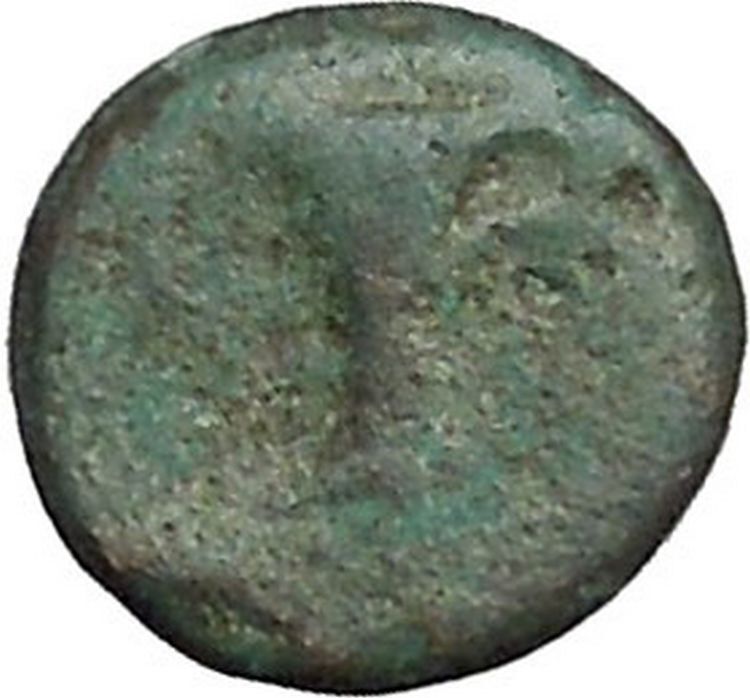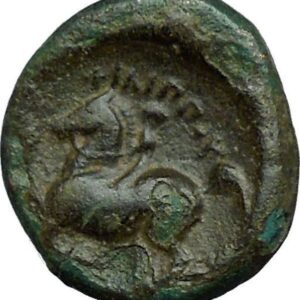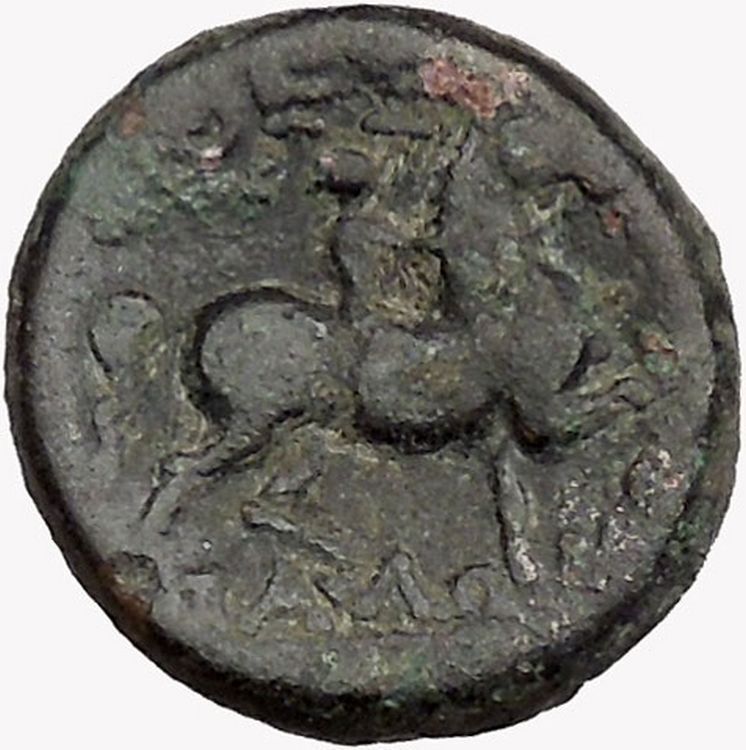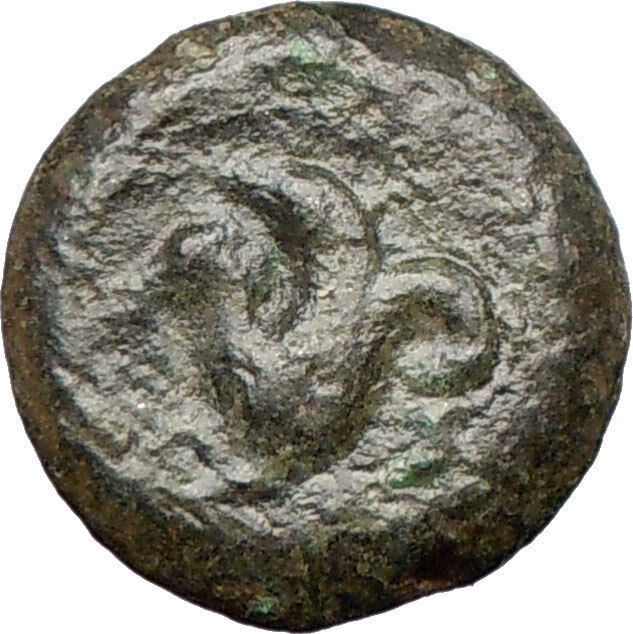|
Greek city of
Istros in
Thrace
Cast wheel money 14mm (1.24 grams) Struck circa 500 B.C.
Reference: SNG BMC 221.
Wheel of four spokes around central dot.
IΣT.
A Milesian colony, its large output of silver coiange in the first half of
the 4th Century suggests
that it was a palce of commercial importance.
You are bidding on the exact
item pictured, provided with a Certificate of Authenticity and Lifetime
Guarantee of Authenticity.
Ancient Histria or Istros (Ιστριη, Thracian
river god
,
Danube
), was a Greek colony or polis (πολις,
city) on the Black Sea
coast, established by
Milesian
settlers to trade with the native
Getae
. It became the first
Greek
town on the present day
Romanian
territory.
Scymnus
of
Chios
(ca 110 BC), the Greek geographer and
poet, dated it to 630 BC.
Eusebius of Caesarea
, some centuries later,
dated its founding to 657 – 656 BC, at the time of the 33rd
Olympic Games
. The earliest documented currency
on Romanian
territory was an 8-gram
silver
drachma
, issued in Histria in the year 480 BC.

Archaeological evidence seems to confirm that all trade with the interior
followed the foundation of Histria. Traders reached the interior via Histria and
the Danube
valley, demonstrated by finds of Attic
black-figure pottery
, coins, ornamental
objects, an Ionian
lebes
and many fragments of
amphoras
.
Amphoras
have been found in great quantity at
Histria, some imported but some local. Local pottery was produced following
establishment of the colony and certainly before mid-6th century. During the
archaic and classical periods, when Histria flourished, it was situated near
fertile arable land. It served as a port of trade soon after its establishment,
with fishing and agriculture as additional sources of income. By 100 AD,
however, fishing was almost the sole remaining source of Istrian revenue.
Around 30 AD, Histria became a
Roman
town. During the Roman period from the
1st to 3rd centuries AD, temples were built for the Roman gods, besides a public
bath and houses for the wealthy. Altogether, it was in continuous existence for
some 14 centuries, starting with the Greek period up to the Roman-Byzantine
period. The Halmyris
bay where was the city founded was
closed by sand deposits and access to the
Black Sea
gradually was cut. Trade continued
until the 6th century AD. The invasion of the
Avars
and the
Slavs
in the 7th century AD almost entirely
destroyed the fortress, and the Istrians dispersed; the name and the city
disappeared.
Geographic
setting
Ancient Histria was situated on a peninsula, about 5 kilometres (3 mi) east
of the modern Romanian
commune of
Istria
, on the
Dobruja
coast. The ancient seashore has since
been transformed into the western shore of
Sinoe Lake
, as the Danube’s silt deposits
formed a shoal
which closed off the ancient coastline.
The current
Sinoe Lake
was at the time the open northern
bay, while another bay on the southern shore served as the port. The acropolis
with sanctuaries was established on the highest point of the coastal plain. The
settlement itself, erected in the 6th century, was 1/2 mile (800 meters) to the
west of the acropolis. The settlement had stone paved streets and was protected
by strong wall. Water was collected along 12.5 mile (20 km) long aqueducts.
Archaeology
The ruins of the settlement were first identified in 1868 by French
archaeologist Ernest Desjardins. Archaeological
excavations
were started by
Vasile Pârvan
in 1914, and continued after his
death in 1927 by teams of archaeologists led successively by Scarlat and
Marcelle Lambrino (1928–1943), Emil Condurachi (1949–1970), Dionisie Pippidi,
Petre Alexandrescu and Alexandru Suceveanu. The Histria Museum, founded in 1982,
exhibits some of these finds. The excavation project and site also features
prominently in the film
The Ister
.
Thrace
(demonym Thracian
/
ənθreɪʃⁱˈ/;
Bulgarian
:
Тракия, Trakiya,
Greek
: Θράκη,
Thráki,
Turkish
:
Trakya) is a historical and geographic area in southeast
Europe
. As a geographical concept, Thrace
designates a region bounded by the
Balkan Mountains
on the north,
Rhodope Mountains
and the
Aegean Sea
on the south, and by the
Black Sea
and the
Sea of Marmara
on the east. The areas it
comprises are southeastern
Bulgaria
(Northern
Thrace), northeastern
Greece
(Western
Thrace), and the European part of
Turkey
(Eastern
Thrace). The biggest part of Thrace is part of present-day Bulgaria.
In Turkey, it is also called
Rumelia
. The name comes from the
Thracians
, an ancient
Indo-European
people inhabiting Southeastern
Europe.
The historical boundaries of Thrace have varied. Noteworthy is the fact that,
at an early date, the
ancient Greeks
employed the term “Thrace” to
refer to all of the territory which lay north of
Thessaly
inhabited by the
Thracians
, a region which “had no definite
boundaries” and to which other regions (like
Macedonia
and even
Scythia
) were added. In one ancient Greek
source, the very Earth is divided into “Asia, Libya, Europa and Thracia”. As the
knowledge of world geography of the Greeks broadened, the term came to be more
restricted in its application: Thrace designated the lands bordered by the
Danube
on the north, by the Euxine Sea (Black
Sea) on the east, by northern
Macedonia
in the south and by the
Illyrian
lands (i.e.
Illyria
) to the west. This largely coincided
with the Thracian
Odrysian kingdom
, whose borders varied in time.
During this time, specifically after the Macedonian conquest, the region’s old
border with Macedonia was shifted from the
Struma River
to the
Mesta River
. This usage lasted until the Roman
conquest. Henceforth, (classical) Thrace referred only to the tract of land
largely covering the same extent of space as the modern geographical region. In
its early period, the
Roman province of Thrace
was of this extent,
but after the administrative reforms of the late 3rd century, Thracia’s much
reduced territory became the six small provinces which constituted the
Diocese of Thrace
. The medieval
Byzantine
theme
of
Thrace
contained only what today is
Eastern Thrace
.
The largest cities of Thrace are:
İstanbul
(European side),
Plovdiv
,
Burgas
,
Stara Zagora
,
Haskovo
,
Edirne
,
Çorlu
and
Tekirdag
.
Most of the Bulgarian and Greek population are Christians, while most of the
Turkish inhabitants of Thrace are Muslims.
Thrace in
ancient Greek mythology
Ancient Greek mythology
provides them with a
mythical ancestor, named
Thrax
, son of the war-god
Ares, who was said to reside in Thrace. The Thracians appear in
Homer
‘s
Iliad
as
Trojan allies, led by
Acamas
and
Peiros
. Later in the Iliad,
Rhesus
, another Thracian king, makes an
appearance. Cisseus
, father-in-law to the Trojan elder
Antenor
, is also given as a Thracian king.
Homeric Thrace was vaguely defined, and stretched from the River
Axios
in the west to the
Hellespont
and
Black Sea
in the east. The
Catalogue of Ships
mentions three separate
contingents from Thrace: Thracians led by Acamas and Peiros, from
Aenus
;
Cicones
led by
Euphemus
, from southern Thrace, near
Ismaros
; and from the city of
Sestus
, on the Thracian (northern) side of the
Hellespont, which formed part of the contingent led by
Asius
. Greek mythology is replete with Thracian
kings, including
Diomedes
,
Tereus
,
Lycurgus
,
Phineus
,
Tegyrius
,
Eumolpus
,
Polymnestor
,
Poltys
, and
Oeagrus
(father of
Orpheus
). In addition to the tribe that Homer
calls Thracians, ancient Thrace was home to numerous other tribes, such as the
Edones
,
Bisaltae
,
Cicones
, and
Bistones
.
Thrace is also mentioned in Ovid’s Metamorphoses in the episode of
Philomela
, Procne, and
Tereus
. Tereus, the King of Thrace, lusts after
his sister-in-law, Philomela. He kidnaps her, holds her captive, rapes her, and
cuts out her tongue. Philomela manages to get free, however. She and her sister,
Procne, plot to get revenge, by killing Itys (son of Tereus and Procne) and
serving him to his father for dinner. At the end of the myth, all three turn
into birds—Procne, a swallow; Philomela, a nightingale; and Tereus, a
hoopoe
.
History
Ancient history
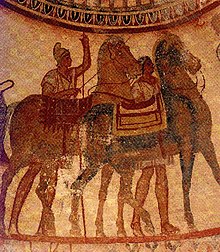
Thracian Tomb of Kazanlak
The indigenous population of Thrace was a people called the
Thracians
, divided into numerous tribal groups.
Thracian troops were known to accompany neighboring ruler
Alexander the Great
when he crossed the
Hellespont
which abuts Thrace, and took on the
Persian Empire
of the day.
The Thracians did not describe themselves as such and Thrace and
Thracians are simply the names given them by the Greeks.[5]
Divided into separate tribes, the Thracians did not manage to form a lasting
political organization until the
Odrysian state
was founded in the 4th century
BC. Like Illyrians
, Thracian tribes of the mountainous
regions fostered a locally ruled warrior tradition, while the tribes based in
the plains were purportedly more peaceable. Recently discovered funeral mounds
in Bulgaria suggest that Thracian kings did rule regions of Thrace with distinct
Thracian national identity.
During this period, a subculture of
celibate
ascetics
called the
Ctistae
lived in Thrace, where they served as
philosophers, priests and prophets.
Medieval history
By the mid 5th century, as the Roman Empire began to crumble, Thracia fell
from the authority of Rome and into the hands of Germanic tribal rulers. With
the fall of Rome, Thracia turned into a battleground territory for the better
part of the next 1,000 years. The eastern successor of the
Roman Empire
in the Balkans, the
Byzantine Empire
, retained control over Thrace
until the 8th century when the northern half of the entire region was
incorporated into the
First Bulgarian Empire
. Byzantium regained
Thrace in the late 10th century and administered it as a
theme
, until the Bulgarians regained
control of the northern half at the end of the 12th century. Throughout the 13th
century and the first half of the 14th century, the region was changing in the
hands of the Bulgarian and the Byzantine Empire(excl. Constantinopole). In 1265
the area suffered a Mongol raid from the
Golden Horde
, led by
Nogai Khan
. In 1352, the
Ottoman
Turks
conducted their first incursion into the
region subduing it completely within a matter of two decades and occupying it
for five centuries.
Modern history
With the
Congress of Berlin
in 1878, Northern Thrace was
incorporated into the semi-autonomous Ottoman province of
Eastern Rumelia
, which united with Bulgaria in
1885. The rest of Thrace was divided among Bulgaria, Greece and Turkey at the
beginning of the 20th century, following the
Balkan Wars
,
World War I
and the
Greco-Turkish War
. Today Thracian is a
strong regional identity in Greece, Turkey, Bulgaria and other neighbouring
countries.
Famous Thracians and people from Thrace
- A number of
Roman emperors
of the 3rd-5th century were
of Thraco-Roman
backgrounds (Maximinus
Thrax,
Licinius
,
Galerius
,
Aureolus
,
Leo the Thracian
, etc.). These emperors
were elevated via a military career, from the condition of common soldiers
in one of the
Roman legions
to the foremost positions of
political power
.
|







